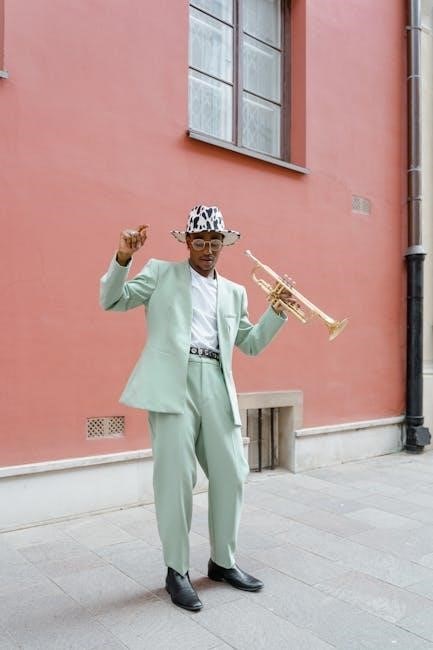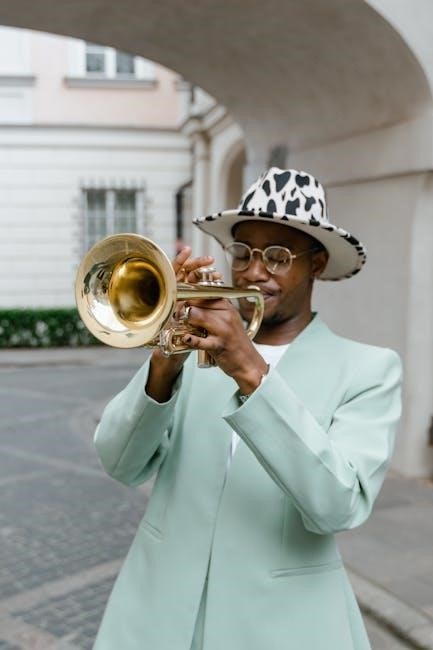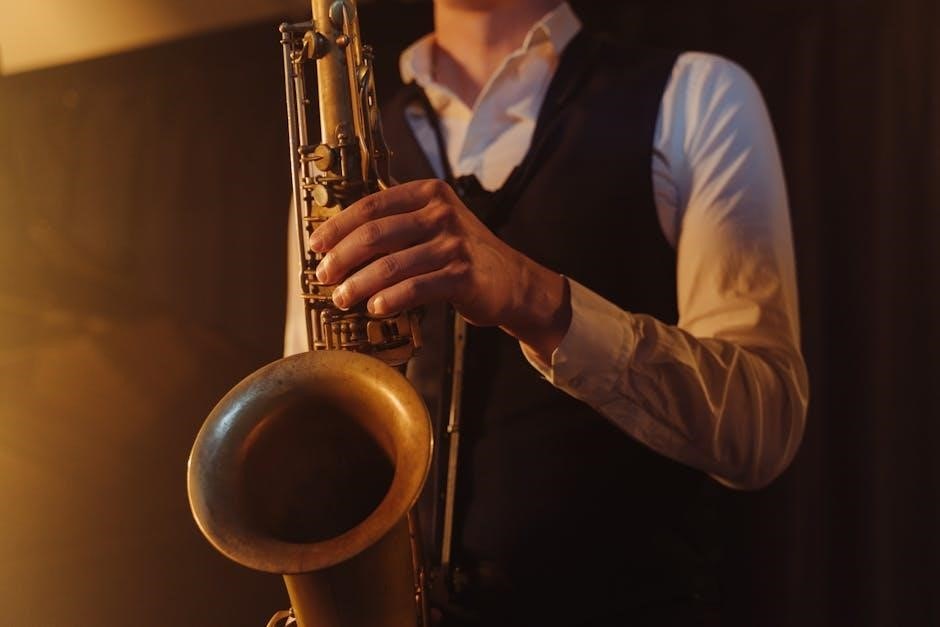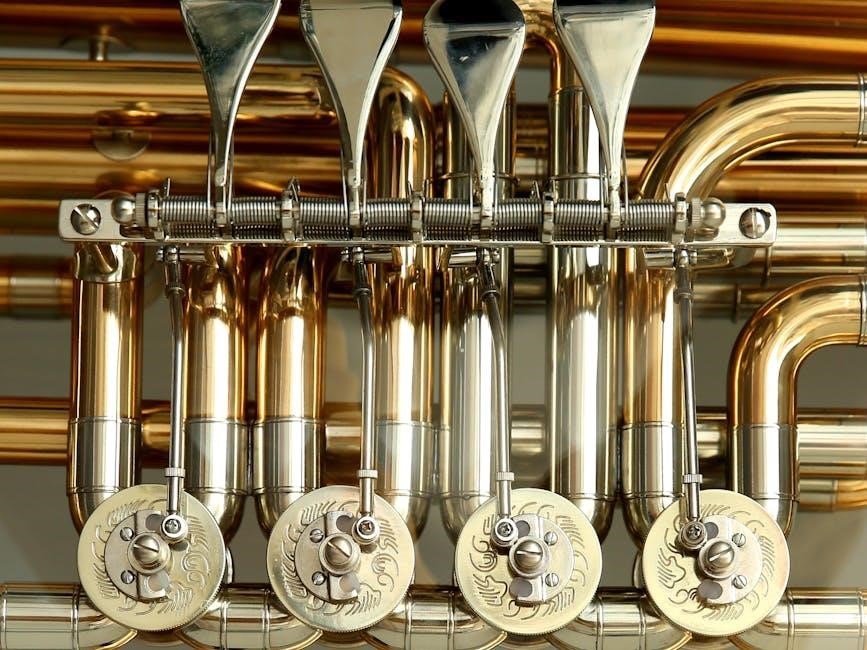The Hummel Trumpet Concerto in E major is a cornerstone of classical trumpet literature, featuring three movements. Its Andante movement is particularly cherished for its lyrical beauty. Composed for Anton Weidinger, it mirrors Haydn’s concerto for the same virtuoso. The concerto is widely available as a PDF for Bb trumpet, ensuring its accessibility to modern musicians.
1.1 Historical Background of the Concerto
Composed in the early 19th century, the Hummel Trumpet Concerto was written for Anton Weidinger, a virtuoso who also inspired Haydn’s concerto. Reflecting the Classical era’s musical transitions, it blends elegance with technical demands. The concerto’s historical significance lies in its role as a cornerstone of classical trumpet literature, showcasing Hummel’s mastery and the evolution of the trumpet as a solo instrument.
1.2 Significance in Classical Music Literature
The Hummel Trumpet Concerto is a cornerstone of classical trumpet repertoire, celebrated for its technical brilliance and lyrical beauty. It stands alongside Haydn’s concerto as a defining work for the instrument. Its balanced structure and melodic richness have made it a favorite in classical music literature, influencing generations of composers and remaining a staple in trumpet education and performance.
Johann Nepomuk Hummel and His Contributions to Music
Johann Nepomuk Hummel, a renowned composer, pianist, and conductor, bridged the Classical and Romantic eras. His works, including the iconic Trumpet Concerto, showcase his mastery of melody and form.
2.1 Biography of Johann Nepomuk Hummel
Johann Nepomuk Hummel, born in 1778 in Pressburg, was a child prodigy who studied under Mozart. He became a prominent composer, pianist, and conductor, blending classical traditions with early romantic influences. His career spanned Europe, influencing later composers and shaping classical music. His legacy endures through works like the celebrated Trumpet Concerto.
2.2 His Role in Classical Music Composition
Hummel was a pivotal figure in classical music, bridging the Classical and Romantic eras. His compositions, including the Trumpet Concerto, showcased masterful orchestration and melodic richness. As a composer and educator, he influenced generations, leaving a legacy of works that remain central to classical repertoire, with his Trumpet Concerto being a testament to his enduring impact.
2.3 Hummel’s Relationship with Other Composers (e.g., Haydn)
Hummel studied under Haydn, forging a deep connection that influenced his compositional style. Both composers wrote trumpet concertos for Anton Weidinger, highlighting their mutual respect. This relationship underscores Hummel’s integration into the classical music circle, with Haydn’s tutelage shaping his artistic voice and contributing to his prominence in the musical landscape of his time.
Structure of the Hummel Trumpet Concerto

The Hummel Trumpet Concerto in E major is structured in three movements. The first movement introduces the trumpet part, which is elaborately developed. The orchestra accompanies with harmonically rich support, creating a balanced interplay between the soloist and ensemble.
3.1 Overview of the Three Movements
The Hummel Trumpet Concerto consists of three movements: Allegro con spirito, Andante, and Rondo. The first movement is lively and technically demanding, showcasing the trumpet’s agility. The Andante is lyrical and expressive, highlighting the instrument’s melodic capabilities. The Rondo finale is vibrant and playful, concluding the concerto with energy and flair;
3.2 Analysis of the Trumpet Part in Each Movement
The trumpet part in Hummel’s concerto demands technical precision and lyrical phrasing. The Allegro con spirito requires brilliant articulation and agility, while the Andante emphasizes expressive, cantabile playing. The Rondo finale combines virtuosic passages with playful motifs, showcasing the soloist’s versatility. Each movement highlights the trumpet’s capabilities, blending classical elegance with technical brilliance.
3.3 The Role of the Orchestra in Accompanying the Trumpet
The orchestra provides harmonic and rhythmic support, creating a balanced dialogue with the trumpet. Woodwinds and strings add texture, while brass sections enhance key moments. The orchestration complements the trumpet’s virtuosity, ensuring a dynamic interplay that highlights the soloist without overwhelming it, maintaining classical equilibrium and elegance throughout the concerto.

Historical Context of the Trumpet Concerto
The trumpet emerged as a solo instrument in the Classical era, with composers like Haydn and Hummel contributing landmark concertos. The keyed trumpet’s development expanded its expressive capabilities, influencing Hummel’s concerto and solidifying the trumpet’s role in classical music.
4.1 The Trumpet as a Solo Instrument in the Classical Period
The trumpet’s role as a solo instrument flourished in the Classical period, driven by innovations like the keyed trumpet. Composers such as Haydn and Hummel created concertos that highlighted its technical and expressive potential, establishing it as a prominent voice in orchestral music.
4.2 The Influence of Anton Weidinger on the Composition
Anton Weidinger, a virtuoso trumpeter, was the dedicatee of Hummel’s concerto. His technical prowess and the capabilities of the keyed trumpet inspired Hummel to craft a piece showcasing both lyrical and virtuosic elements, tailored to Weidinger’s exceptional abilities, thus influencing the concerto’s structure and style significantly.
4.3 Comparisons with Other Trumpet Concertos of the Era
Hummel’s concerto stands alongside Haydn’s trumpet concerto as a pinnacle of classical trumpet music. Both were written for Anton Weidinger, reflecting similar structural and stylistic elements. Hummel’s work, however, offers a distinct lyrical depth and harmonic richness, distinguishing it within the era’s repertoire while maintaining the virtuosic demands characteristic of the period.
Sheet Music and PDF Availability
The Hummel Trumpet Concerto is widely available in PDF format from publishers like Henle Verlag. It is accessible for Bb trumpet and piano, ensuring ease for modern musicians.
5.1 Sources for Downloading the Hummel Trumpet Concerto in PDF
The Hummel Trumpet Concerto in E major is widely available for download in PDF format. Reputable sources include Henle Verlag, offering high-quality scores, and platforms like MuseScore, where arrangements for Bb trumpet and piano can be found. Additionally, many digital libraries provide free or subscription-based access to the concerto, ensuring accessibility for musicians and enthusiasts alike.
5.2 Popular Editions and Publishers (e.g., Henle Verlag)
Henle Verlag is a leading publisher of the Hummel Trumpet Concerto, offering meticulous editions. Other notable publishers include Breitkopf & Härtel and Editions Bim, providing high-quality scores. These editions are cherished for their accuracy and clarity, making them essential for performers and scholars. Digital versions are also available, catering to modern musicians’ preferences for convenience and accessibility.
5.3 Differences Between Solo and Orchestral Scores
The solo score focuses solely on the trumpet part with piano accompaniment, ideal for practice. The orchestral score includes all instrumental parts, providing a comprehensive view of the composition. Both are available in PDF format, catering to different needs: soloists prefer the condensed version, while orchestral scores are essential for ensemble performances and detailed study of Hummel’s orchestration.

Arrangements and Transcriptions
The Hummel Trumpet Concerto is available in various arrangements, including versions for Bb trumpet and piano, solo Eb trumpet, and modern adaptations with added cadenzas.
6.1 Transcriptions for Bb Trumpet and Piano
Transcriptions of Hummel’s concerto for Bb trumpet and piano maintain the original’s musical integrity. These arrangements make the piece accessible for practice and performance. Michel Rondeau’s version is particularly popular, offering a balanced reduction of the orchestral accompaniment. Scores and parts are widely available in PDF and MIDI formats, catering to both students and professionals for study and recital purposes.
6.2 Arrangements for Solo Eb Trumpet
Arrangements for solo Eb trumpet highlight the concerto’s technical and lyrical qualities. Michel Rondeau’s version includes a cadenza, showcasing the instrument’s capabilities. These arrangements are popular among advanced players, offering a faithful representation of Hummel’s original work. PDF and MIDI files are widely available, making the concerto accessible for study and performance in its original key.
6.3 Modern Adaptations and Cadenza Additions
Modern adaptations of the Hummel Trumpet Concerto often include cadenza additions by arrangers like Michel Rondeau, enhancing the piece’s technical brilliance. These adaptations maintain the original’s lyrical charm while offering fresh interpretations. PDF and MIDI files of these versions are widely available, allowing musicians to explore new dimensions of the concerto while staying true to its classical roots.
Performance Considerations
Performing the Hummel Trumpet Concerto requires precise articulation and dynamic control. Trumpet players must navigate technical demands while maintaining lyrical phrasing. Recommended tempos and expressive nuances ensure a balanced interpretation, reflecting the concerto’s classical elegance and emotional depth.
7.1 Technical Challenges for Trumpet Players
The Hummel Trumpet Concerto presents notable technical challenges, including intricate finger dexterity, precise articulation, and breath control. The Allegro con spirito movement demands rapid passages and clarity, while the Andante requires expressive, sustained playing. Accurate intonation and phrasing are crucial, especially in the concerto’s upper register sections, making it a demanding yet rewarding piece for advanced trumpet players to master.
7.2 Interpretation and Articulation Guidelines
Interpreting the Hummel Trumpet Concerto requires a balance of clarity and expressiveness. Articulations should be crisp in the Allegro con spirito, with precise staccato and legato phrasing. The Andante demands lyrical, flowing lines, while dynamics and rubato should enhance emotional depth. Trumpet players must emphasize nuanced phrasing and stylistic accuracy to capture the concerto’s classical elegance and technical brilliance effectively.
7.3 Recommended Tempos and Dynamics
For the Hummel Trumpet Concerto, recommended tempos include Allegro con spirito at 130 BPM, Andante around 66-76 BPM, and Rondo Allegro con brio at 132 BPM. Dynamics range from pianissimo to fortissimo, with careful attention to phrasing and subtle rubato. Trumpet players should emphasize contrasting dynamics, such as f and p markings, to highlight the concerto’s dramatic and lyrical contrasts effectively.

Famous Performances and Recordings
Notable recordings include Maurice André with the Berlin Philharmonic and Håkan Hardenberger with the Academy of St. Martin in the Fields. These performances highlight the concerto’s brilliance and emotional depth, showcasing its enduring appeal in classical music.
8.1 Notable Trumpet Soloists Who Have Performed the Concerto
Maurice André and Håkan Hardenberger are renowned for their interpretations. André’s technical brilliance and Hardenberger’s lyrical phrasing have set benchmarks. Their recordings, often with esteemed orchestras, remain definitive, inspiring trumpet virtuosos globally. These performances exemplify the concerto’s timeless appeal and technical demands, making them essential listens for trumpet enthusiasts and classical music aficionados alike.
8.2 Recordings with Orchestras and Conductors
Iconic recordings include Maurice André with the Vienna Symphony Orchestra and Håkan Hardenberger alongside the London Philharmonic. These collaborations highlight the concerto’s grandeur, blending orchestral richness with solo brilliance. Conductors like Claudio Abbado and Riccardo Muti have also led notable performances, ensuring the work’s legacy endures across diverse interpretations and acoustic settings, each offering unique insights into Hummel’s masterpiece.
8.3 Critical Reception of the Concerto in Performances
The Hummel Trumpet Concerto has garnered widespread critical acclaim for its masterful blend of technical brilliance and lyrical elegance. Performances by Maurice André and Håkan Hardenberger are particularly celebrated for their precision and emotional depth. Critics often highlight the concerto’s ability to showcase both the trumpet’s agility and its capacity for expressive melodies, making it a timeless favorite in classical music repertoire.

Educational Value of the Concerto
The Hummel Trumpet Concerto is a vital pedagogical tool, fostering technical mastery and musical expression. It is widely used in trumpet pedagogy, offering students a challenging yet rewarding repertoire piece that enhances both technical skill and interpretive understanding.
9.1 Use in Trumpet Pedagogy and Teaching
The Hummel Trumpet Concerto is a cornerstone in trumpet education, offering students a comprehensive technical and musical challenge. Its availability in PDF formats enhances accessibility for both teachers and learners, providing a detailed framework for developing articulation, phrasing, and tone production. Educators often use the concerto to refine students’ skills in interpreting classical trumpet repertoire effectively.
9.2 The Concerto as a Repertoire Piece for Students
The Hummel Trumpet Concerto is a staple in educational repertoire, offering students a balanced blend of technical and musical demands. Its availability in PDF formats makes it easily accessible for study and performance; The concerto’s three movements provide a comprehensive workout, from the lively Allegro to the lyrical Andante, making it an ideal piece for advancing students to showcase their skills.
9.3 Analytical Studies for Music Theory and History
The Hummel Trumpet Concerto is a valuable subject for analytical studies, offering insights into classical composition techniques. Its three-movement structure, thematic development, and harmonic richness provide fertile ground for music theory analysis. Historically, it reflects the evolution of the trumpet as a solo instrument, making it a significant piece for understanding late Classical-period music. PDF scores facilitate detailed study.

Cultural and Historical Impact
The Hummel Trumpet Concerto is a landmark piece that elevated the trumpet’s role in classical music, influencing later composers and remaining a staple in trumpet repertoire.
10.1 The Concerto’s Place in Trumpet History
The Hummel Trumpet Concerto holds a pivotal place in trumpet history, showcasing the instrument’s technical and expressive capabilities. Composed for Anton Weidinger, it exemplifies the classical trumpet’s evolution and remains a cornerstone of trumpet repertoire, inspiring generations of musicians and influencing the development of classical and modern trumpet music.
10.2 Its Influence on Later Composers and Trumpet Music
Hummel’s concerto significantly influenced trumpet music, setting a standard for subsequent composers. Its structural clarity and melodic richness inspired later works, shaping the classical trumpet repertoire. Modern composers continue to draw from its harmonic and technical innovations, ensuring its legacy endures in both educational and performance contexts.
10.3 Cultural Significance in Classical Music Festivals
The Hummel Trumpet Concerto holds a revered place in classical music festivals, celebrated for its virtuosic brilliance and emotional depth. Its inclusion in major festivals highlights its enduring appeal, connecting audiences with the rich heritage of classical trumpet music while inspiring new generations of musicians and enthusiasts alike.

Availability in Digital Libraries and Platforms
The Hummel Trumpet Concerto is widely accessible in digital libraries like MuseScore and IMSLP, offering PDF and MIDI downloads. Platforms such as Musicnotes and Henle Verlag provide high-quality scores, ensuring musicians can easily access both solo and orchestral versions for study and performance.
11.1 Open-Access Platforms Offering the PDF
Open-access platforms like MuseScore, IMSLP, and Archive.org provide free PDF downloads of the Hummel Trumpet Concerto. These platforms offer high-quality scores, enabling musicians and educators to access the concerto without subscription fees. Formats include solo trumpet parts and full orchestral scores, catering to both performers and enthusiasts seeking to explore this classical masterpiece.
11.2 Subscription-Based Services with the Score
Subscription-based services like Musicnotes, Sheet Music Plus, and J.W. Pepper offer high-quality PDF scores of the Hummel Trumpet Concerto. These platforms provide access to both solo and orchestral parts, ensuring musicians and educators can download the concerto conveniently. Subscription plans often include additional benefits, such as unlimited downloads and exclusive content.
11.3 Availability in Academic and Institutional Libraries
Many academic and institutional libraries offer access to the Hummel Trumpet Concerto in PDF format. Universities with strong music programs, such as the Moscow State Conservatory, often include it in their collections. These libraries may provide digitized scores for educational purposes, ensuring students and researchers can access this essential work. Availability varies by institution but is widespread among music-focused libraries.

Comparisons with Other Trumpet Concertos

Hummel’s concerto rivals Haydn’s in virtuosity, offering a unique blend of lyrical and technical demands. Its structure and orchestration set it apart from other classical trumpet works.
12.1 Haydn’s Trumpet Concerto
Haydn’s Trumpet Concerto, also composed for Anton Weidinger, shares similarities with Hummel’s concerto in its classical structure and virtuosic demands. Both concertos highlight the trumpet’s lyrical and technical capabilities, showcasing Weidinger’s influence. While Haydn’s concerto is known for its balanced phrasing and orchestral integration, Hummel’s work often features more elaborate cadenzas and harmonic richness, distinguishing it within the classical trumpet repertoire.
12.2 Other Classical Trumpet Concertos
Besides Hummel, composers like Vivaldi and Telemann contributed notable trumpet concertos. These works, often in three movements, highlight the trumpet’s virtuosic potential. While sharing classical structural elements, each concerto exhibits unique stylistic traits. Vivaldi’s concertos, for instance, feature bold contrasts, whereas Telemann’s emphasize melodic grace. These pieces, along with Hummel’s, form a rich repertoire for trumpet, showcasing its evolution in classical music.
12.4 Modern Trumpet Concertos Inspired by Hummel
Modern composers often draw inspiration from Hummel’s concerto, blending its classical structure with contemporary flair. Many modern works incorporate Hummel’s lyrical and virtuosic elements, while experimenting with new harmonies and rhythms. These concertos, available as PDFs, reflect Hummel’s enduring influence, offering fresh interpretations that keep his musical legacy vibrant and relevant in today’s trumpet repertoire.

Leave a Reply
You must be logged in to post a comment.